The depletion of natural resources has made designers and builders keenly aware of the need to minimize their consumption of materials. Alongside this, another practice that has gained acceptance is using components made from recycled materials. This approach has grown in popularity in recent years, thanks to the establishment of municipal collection and recycling programmes, which provide raw materials for the manufacture of such products. This chapter describes some recycled components commonly available to those who wish to include them in their designs.
While foundations are typically constructed from tried and tested poured concrete, there are methods that integrate recyclable materials safely and durably with traditional approaches. For example, an opportunity exists to recycle materials through the choice of aggregate. Old concrete can be crushed to create high quality and well-graded aggregate for foundations. These aggregates are not only more angular, with a lower particle density than typical virgin base ones, but they are also coated with a residual cement-like paste, which increases the roughness of their surface, lowers their specific gravity and increases their water absorption qualities (Edil and Schaertl 2010).
Fly ash is another recyclable product that can be used in concrete production as a substitute for Portland cement. It is derived from combustion products at coal-fuelled electric power plants, and typically replaces 20 to 35 per cent of the cement used in concrete without adding to cost when compared to conventional concrete (Headwaters 2005, Sustainable Sources 2011e). Fly ash not only benefits the environment by using up waste, but also improves the concrete’s workability, reduces water content, lowers the required time for hydration, enhances its strength, increases its durability and improves its resistance to chemical attack (Headwaters 2005, Sustainable Sources 2011e). Other recycled materials such as slag cement and silica can also be used as replacements for Portland cement (Portland Cement Association 2009).
Insulated concrete forms (ICFs), which are structurally safe alternatives to poured or breeze block wall foundations, can also present opportunities to use recycled materials when such innovative integrations are offered (Garcia 2009). Typically made from expanded polystyrene (EPS) and other foam insulation, ICFs are hollow forms that can be interlocked, stacked and filled with concrete and rebars on-site to produce insulated foundations, which are up to 25 per cent stronger than conventional poured concrete foundations (ARXX 2011). Furthermore, it is estimated that houses built with ICFs require 44 per cent less energy to heat and 32 per cent less energy to cool than wood-framed houses of the same size. They also have high acoustic insulation qualities (ARXX 2011). Two products to choose from are the RASTRA ICF and the Durisol ICF. While the RASTRA models are made from a mixture of 85 per cent recycled polystyrene and 15 per cent cement, the Durisol models are made from 80 per cent recycled wood from industrial waste bonded with Portland cement (Rastra 2011, Durisol 2011).
There have also been many innovations in the use of recycled materials for structural wood framing and interior finishes. Composite wood products, for example, are fabricated from wood particles glued and compressed together to create products that are superior in many regards to traditional, solid sawn lumber. Composite products include chipboard, medium density fibreboard (MDF) and wooden I-beams, all of which offer greater strength, longer spanning distances, higher consistency and better quality than regular lumber. Furthermore, such engineered wood products cost less and use 32 per cent more of each tree than processed lumber (Composite Panel Association 2011, Garcia 2009).
Another framing innovation that uses recycled materials is plastic wood. It is fabricated from 100 per cent recycled plastic and is substantially superior to wood products. Since it is made entirely from plastic, it can be manufactured in any required shape or size and is very durable, corrosion-resistant, waterproof, rot-proof, maintenance-free, non-toxic, UV-resistant, splinter-free, non-slip and insect-proof. Furthermore, it does not require storage protected from the elements and can be assembled, nailed or screwed into like a regular piece of solid sawn lumber. Due to the durability of these products, some companies offer 20-year warranties (Taylors 2011, Plastic Lumber Depot 2011).
•Depletion of natural resources
•Development of products made of recycled materials
•Greater environmental awareness
•Advances in manufacturing
INNOVATIONS
•Aggregate made from recycled concrete
•Fly ash as a substitute for cement • Insulated concrete forms (ICFs)
•Composite wood products for framing
•Plastic wood
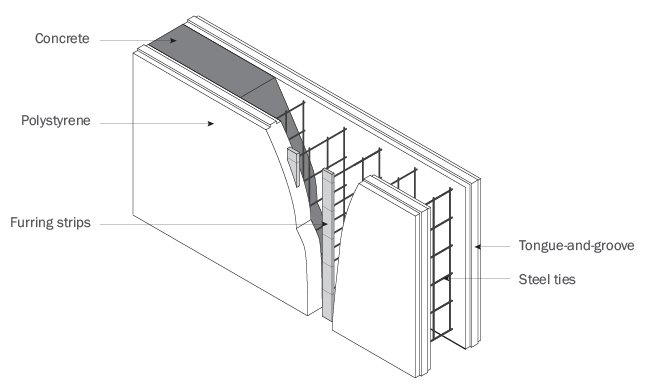
Figure 15.1:Cross section of an Insulated Concrete Form (ICF).

Figure 15.2:Cross section of structural insulated panel (SIP).
Recycled framing products also extend to structural insulated panels (SIPs), which are thick panels with a core of rigid foam insulation covered by a layer of recycled materials, such as oriented strand board (OSB), plywood, fibre cement board or steel. The panels are prefabricated and customized to greatly ease the on-site assembly process. In terms of performance, they offer airtight systems, higher thermal resistance and superior load resistance (Garcia 2009).
Steel, while less commonly used in residential framing, can be made from recycled materials. Items such as used steel studs and metal shipping containers come from 67 to 100 per cent recycled steel and can be ordered to the exact required length, reducing construction waste. Despite being rot- and insect-proof and more dimensionally accurate than wood, steel studs are priced competitively in relation to wooden frames. Furthermore, their installation costs less and they can be recycled once their use has ended (SCAFCO 2009, Garcia 2009).
Exterior cladding can also be constructed from multiple recyclable products, which, after the lifespan of the building is up, can be reused. While many of these products attempt to mimic the look and texture of traditional wood siding, they can be constructed from different materials. Fibre cement siding, for example, is made from Portland cement, more than 30 per cent fly ash, sand and cellulose fibres and can be made to look like masonry or stucco. Unlike traditional wood siding, which is vulnerable to fire, rot, insects and weather, fibre cement siding is durable and offered by manufacturers who are willing to guarantee it for up to 50 years. The disadvantage of this product, however, is that it cannot be recycled (Garcia 2009, James Hardie 2011).
Vinyl siding is another cladding product that offers high durability and ease of maintenance with many aesthetic options. It is primarily manufactured from polyvinyl chloride (PVC) and sold in differing profiles, shapes and colours while still being cost-effective. It is fabricated with 60 per cent pre- and post-consumer recycled content and can be assembled easily due to its embedded notches and nailing holes. After use, like other plastic products, this siding can be recycled (Vinyl Siding Institute 2009).
Engineered wood, also known as composite wood, siding is similar to the above-mentioned siding technologies. While wood–glue laminates are made from 100 per cent recycled preconsumer wood fibres; they are not recyclable after usage and therefore only have a single life. The product is usually offered with a 25-year warranty on the substrate and 15 years on the finish. This product requires more maintenance than the two previously mentioned siding materials. The main advantage of this siding is that it is environmentally friendly due to the 100 per cent recycled products used in its fabrication (Louisiana-Pacific Cor. 2011).
Because there are plenty of materials with high heatresistance values, for homes built with recycled materials, thermal insulation offers a variety of reusable products. Glass, plastic, cotton and newspapers can all be made into rigid boards, blocks, loose fill, rolls and Batt types of insulation, depending on R-values and local climate. Common products made of these materials and systems are cellulose and fibreglass insulations, mineral wool, cotton and spray polyurethane foam.
While residential roofing is traditionally made from asphalt shingles – which in themselves can be recycled from old tires – there are many other forms of roofing that can come from recycled products. Materials such as aluminium, plastic and rubber also exist in a form made from recycled products, and can be re-used.
With increased use, many products made with recycled content are becoming cost competitive. It is likely that sometime in the near future we will see a home whose components are entirely built from these products.
15.1 BUILDING WITH RECYCLED MATERIALS |
|
Project |
Big Dig House |
Location |
Lexington, Massachusetts, USA |
Architect |
SsD (Single Speed Design) |
Some argue that ‘one man’s trash is another man’s treasure’. The owner of the Big Dig House in Lexington, Massachusetts was one of the principal engineers of the American Big Dig initiative. Recorded as one of the most expensive civil engineering projects in American history, the Big Dig consisted of dismantling the elevated and congested I-93 Highway in Boston and replacing it with a central underground tunnel that changed the cityscape of Boston’s downtown roadways. The project was carried out from 1991 to 2006, and produced a significant amount of leftover materials, including reinforced concrete slabs and steel girders. The plan was to dispose of these materials in a landfill; however, one of the engineers opted to use the deconstructed materials to build his own house. In collaboration with the firm SsD (Single Speed Design), the homeowner reused over 272,155 kg (600,000 lb) of steel and concrete to build a house that measured 353 m2 (3,800 sq ft). The architects tried to use as many recycled materials as possible. To reduce time and labour, the structural elements were constructed from materials used as found; without further adjustments to the salvaged pieces. The foundation was constructed from aggregate recovered from the concrete rumbles, salvaged steel I-beams were used for the structural framing and reclaimed concrete panels were placed on the beams that formed the main floors of the two-storey house. The roof rafters were constructed using two concrete panels that had previously been used as a temporary ramp to the Boston’s Tobin Bridge, and 0.69 m (2.25 ft) of grey-painted girders can be found in the roof. Indoors, the steel framing allows for non-load bearing walls and provides opportunities for a large expanse of windows and a two-storey ceiling height. The clean and sharp volumes of the interior are ‘softened’ by the warmth of the eggshell coloured walls, roof gardens and the pergola over the front facade. Furthermore, the living room and the kitchen, complete with hardwood ceilings and fabric furniture, provide an intimate ambience for the homeowners.
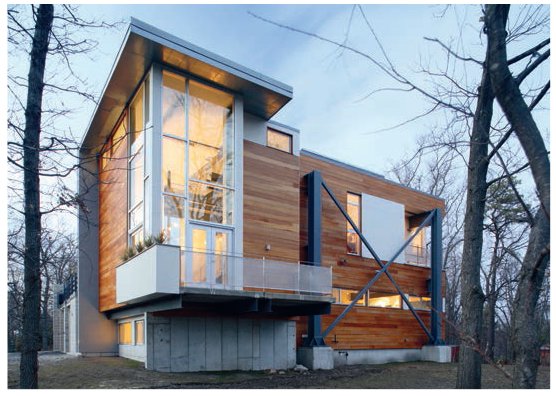
South-east view shows some of the recycled steel beams.
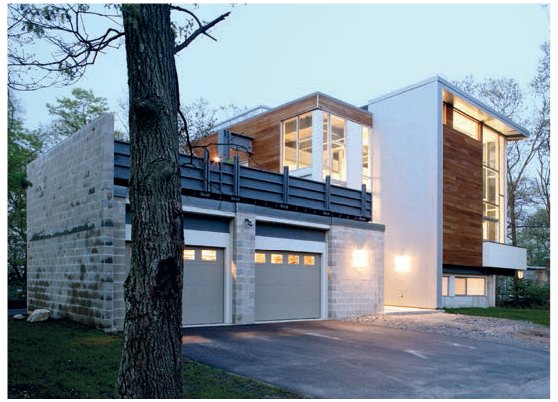
South-west view shows other recycled materials.

East elevation showing the recovered steel components.
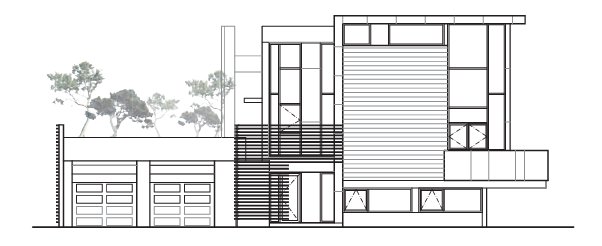
South elevation. The roof was constructed using two previously used concrete panels.
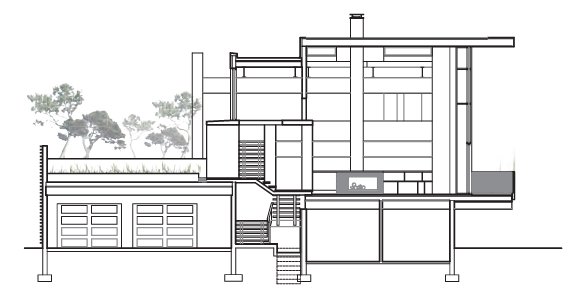
Section.
The project received the American Institute of Architects and Boston Society of Architectures Housing Design Award. It represents a strategic front-end planning for future public developments such as schools, libraries or offices. Recovering and reusing materials from obsolete infrastructures can save valuable resources, energy and money.
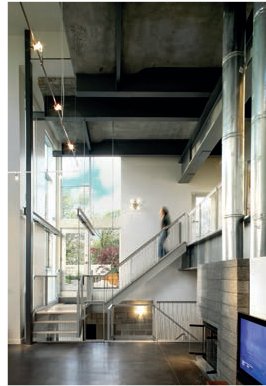
View of the mezzanine where one can see the street girders.
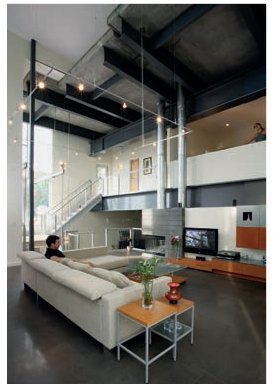
View of the living room where the interior was softened with eggshell coloured walls.
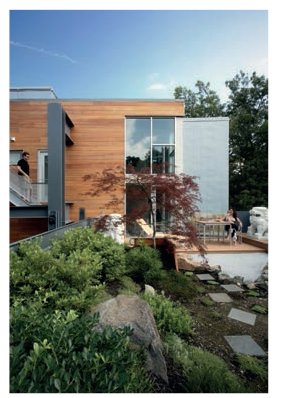
View of the house from the garden.
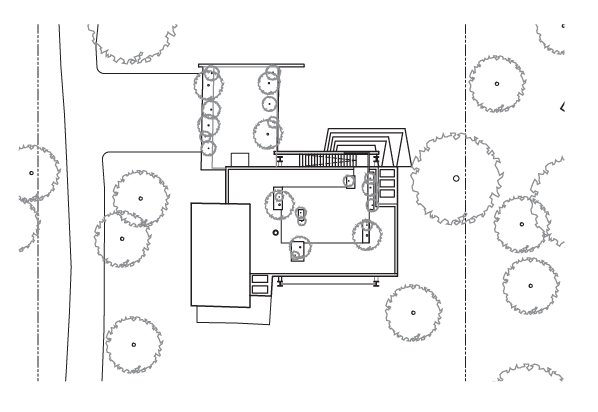
Site plan.
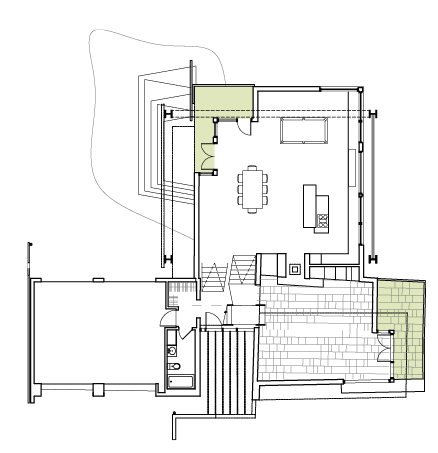
Ground floor. The foundation of the house was constructed of recycled aggregate.
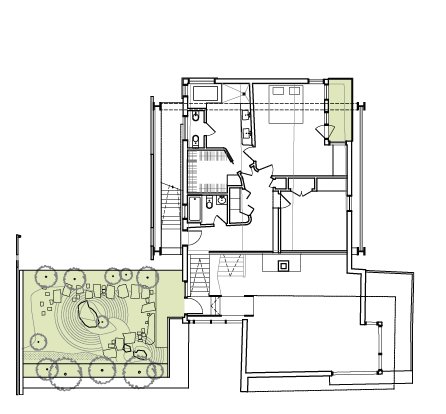
First floor.

Roof plan with the garden.
